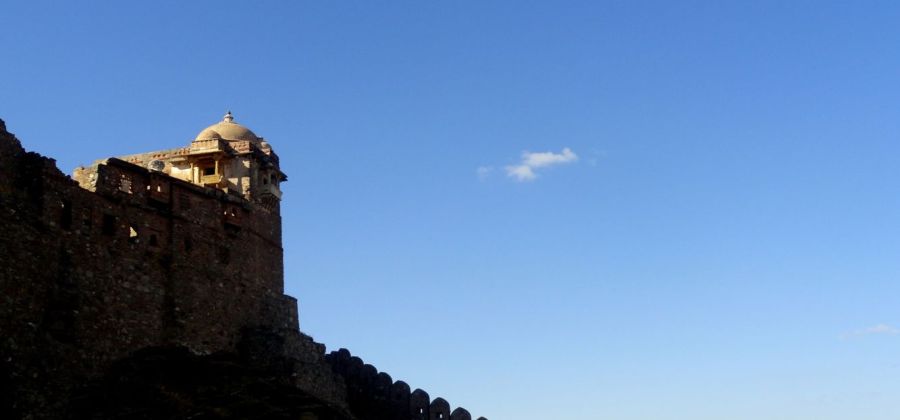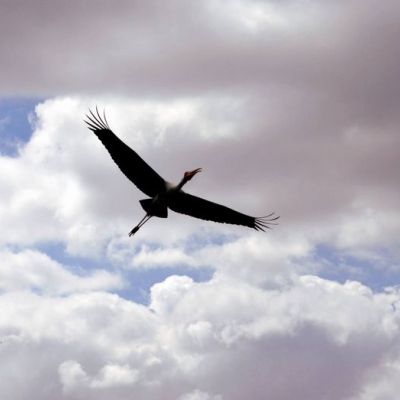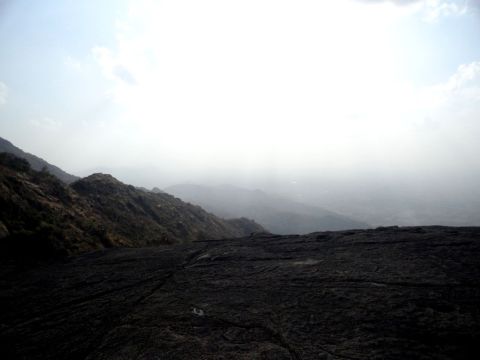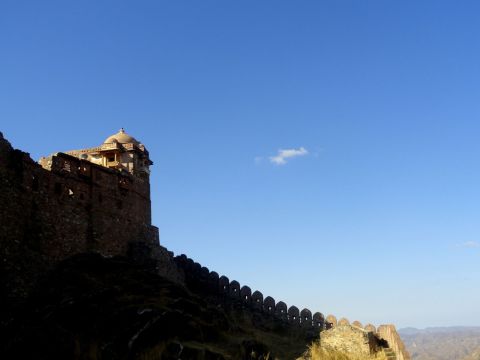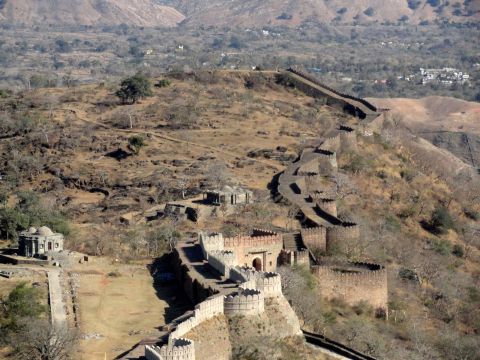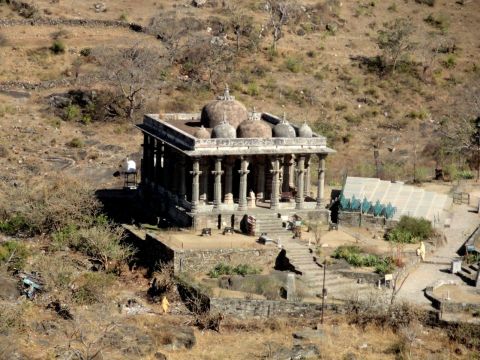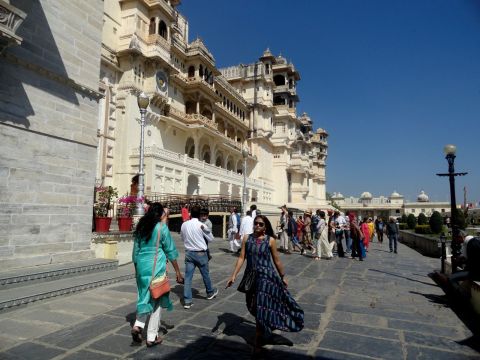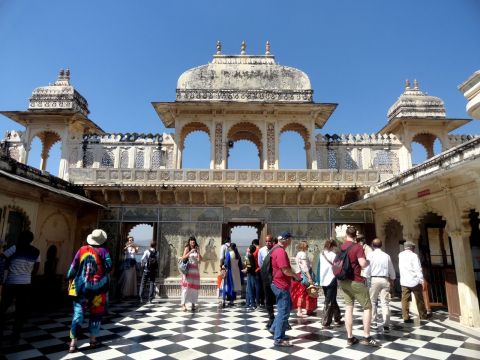Serenity and Discovery: Rajasthan Revealed
Amidst the backdrop of the first COVID-19 case in India, join an intrepid journey through Rajasthan's historical treasures, spiritual retreats, and breathtaking landscapes.
This was the time when the first COVID-19 case in India was reported. I planned a short trip with my parents during their spiritual retreat at Mount Abu. Since it was a trip with my 1-year-old son during a panic-stricken period, no one agreed to take me and my son on the trip. However, I managed to convince everyone for the trip, and I would say I earned it.
In 1999, we visited various places in the state of Rajasthan. We covered nearly all the major tourist destinations, starting our journey from Jaipur and then travelling to Ajmer, Pushkar, Chittorgarh, Udaipur, Ranakpur, Mount Abu, Jodhpur, Bikaner, Amber, and Bharatpur. It was an incredible 20-day tour. If you have enough time, I would recommend you to consider going on this Rajasthan trip. It's worth visiting Rajasthan to explore the rich history and culture of the warrior Rajputs at least once in a lifetime. This time, I planned a 4-night, 5-day tour, visiting the major tourist spots of Mount Abu, Kumbhalgarh, and Udaipur.
Our journey began from Bangalore early in the morning, without the stress of COVID, and with an attitude of "let's see what happens." Looking back from a tour perspective, I'm thankful that we weren't fully aware of the dreaded virus at that time. The flight from Bangalore to Ahmedabad took 2 hours. After arriving at the Ahmedabad airport, we had our morning tea. The cab we had booked from Mount Abu was waiting for us at the airport. After tea, we left the airport and started our journey to Mount Abu.
Before leaving Ahmedabad, we had breakfast, which included a special Gujarati roti called Bhakri with vegetables. The journey from Ahmedabad to Mount Abu took almost 5 hours. We took another tea break on the way. We reached Abu Road in the late afternoon. Our guest house was booked in the spiritual organization at Abu Road, where my parents attended a conference. The organization and university are known as Brahma Kumaris. We settled into our guest house and explored the Brahma Kumaris campus. We had dinner in the dining hall inside the campus, along with hundreds of other visitors. Exhausted, we went to bed early after returning to the guest house.
The next day was filled with conference talks, so we didn't have any travel plans. I started my day with morning meditation, followed by breakfast and a self-guided campus tour. The name of the complex, Shantivan, felt appropriate as peace was prevalent everywhere within the complex, even in the food. Simple food often provides a sense of satisfaction. The location we were in encouraged deep introspection, especially for someone like me who tends to rely on Zomato and Swiggy for ordering food, associating it with entertainment and happiness.
The Brahma Kumaris is a spiritual university that focuses on 'self-transformation' towards purity, love, and peace. Not classified as a religion, it holds that the true purpose of religion is to offer insight into the meaning of human life, and the lack of this understanding often leads to conflicts among religious groups. Their slogan, 'When we change, the world changes,' underscores the importance of personal transformation. The teachings of Brahma Kumaris help individuals transition from a controlling mindset to one of influence, drawing upon their inner power. The path it illuminates is that of self-cultivation.
During the campus tour and interactions with the members of Brahma Kumaris, I learned about their social activities. Apart from meditation training, they offer courses like 'positive thinking,' 'living values,' and 'self-management leadership' in various corporations and academic institutions. They also provide medical facilities to the local community through their Global Hospital. Dr. APJ Abdul Kalam collaborated with the Global Hospital and Research Centre in Mount Abu to develop a project focused on a lifestyle intervention program aimed at reversing coronary artery disease. Their commitment extends to the environment as well, with the establishment of a solar thermal power plant.
After a day of immense contentment, I planned the next day's tour which involved sightseeing at Mount Abu.
We booked a car from the Brahma Kumaris transport and travel wing in the morning after breakfast. Our tour started around 10:00 AM and made our way towards Nakki Lake in Mount Abu. The path to the lake from the parking area leads through a market where tourists can shop. The lake is surrounded by lush green mountains from the Aravalli range. A notable attraction is the Toad Rock on a nearby hill, which resembles a toad. The lake offers boating facilities, although this time we chose not to boat, only taking photographs with my son. It was a change in the mode of enjoyment compared to my previous visit when I went boating there during my 9th standard.
Next, we visited Achalgarh village, home to the Achalgarh fort and Achaleswar Mahadev temple. The fort was built by the Paramara dynasty and later restored by Rana Kumbha of Mewar. The fort is now in ruins, while the Achaleswar temple is situated just outside the fort. Local beliefs suggest that the rock within the temple bears the footprints of Lord Shiva.
We then headed to the famous Jain temple, Dilwara, renowned for its intricate marble carvings. The detailed craftsmanship on the ceiling of the temple serves as a prime example of the skilled workmanship during the 11th century. Dilwara Temple welcomes tourists from 12 PM to 5 PM. Similarly, Nakki Lake is open from 9:30 AM to 6 PM, and Achalgarh Fort from 5 AM to 7 PM.
Subsequently, we hurried to the Universal Peace Hall of the Brahma Kumaris, a notable tourist attraction in Mount Abu. Unfortunately, we arrived too late for lunch at the main campus of Brahma Kumaris, known as Madhuban campus. Notably, the Madhuban campus is situated just across from the Universal Peace Hall.
We retraced our steps to the sunset point near Nakki Lake. This time, we embarked on a 1-kilometer trek to reach the summit of the sunset point. The sight of the lush green forests in the Aravalli ranges was truly breathtaking. Even after the sun had set, we remained seated for a while longer. The location was ideal for meditation, providing a perfect setting for contemplation.
After a full day of sightseeing in Mount Abu, we returned to the Shantivan campus located in Abu Road. Our plan for the following day involved traveling to Udaipur, with a scheduled visit to the notable site, the Great Wall of India—Kumbhalgarh Fort. This was a place we had missed during our previous visit to Rajasthan.
The next morning, we started our journey to Kumbhalgarh after breakfast at Abu Road. We made two stops along the way. The first was to capture the beautiful view of the Aravalli range on camera, and the second was for lunch at a traditional Rajasthani-style building adorned with royal paintings on the walls.
The journey to Kumbhalgarh Fort through the Kumbhalgarh Wildlife Sanctuary turned out to be the most delightful experience of our entire trip. The fort seemed to appear out of nowhere after we crossed the forested area. We reached Kumbhalgarh in the late afternoon. Since the fort is located at the top of Aravalli hills, we had to trek from the entrance, Ram Pol. Opting for a guided tour of this colossal fort, we embarked on the ascent to the summit with my child in my lap—my first time attempting such a feat. Alongside this physical challenge, we had the opportunity to relish panoramic vistas of the surroundings and absorb the enthralling history of the fort's significant structures as narrated by our guide.
Kumbhalgarh Fort was constructed in the Aravalli hills by Rana Kumbha during the 15th century. The fort's wall is believed to be the second longest wall in the world, following the Great Wall of China. This fort serves as the birthplace of the renowned Rajput warrior Maharana Pratap. It is strategically positioned amidst mountain peaks and forests, rendering it virtually invisible to enemies. It consistently provided shelter to the rulers of Mewar during times of war. Despite numerous attempts by various rulers in India to conquer it, the fort remained unconquered. Even the formidable Mughal emperor Akbar managed to capture the fort with support from Raja Udai Singh of Mewar and Raja Man Singh of Amer, but only for a year, as it was subsequently recaptured by the brave Mewar ruler Maharana Pratap. The fort continues to echo the victory anthem for its courageous sons.
The main attractions of the fort are its palaces and temples. The three primary palaces include Kumbha Mahal, the two-storied Rana Kumbha's Palace (now in a state of ruin), Jhalia Ka Malia (believed to be the birthplace of Maharana Pratap), and Badal Mahal, constructed by Rana Fateh Singh, which stands at the highest point of the fort. Additionally, there are 360 temples, both Hindu and Jain, scattered across the fort area. Most of these temples were erected during the reign of Rana Kumbha. Among them, the highly recommended temple to visit is the Neelkantha Mahadeva temple. Situated amidst the hilly landscape, it is surrounded by thorny shrubs.
We enjoyed the magnificent view of the Aravalli range, Kumbhalgarh Wildlife Sanctuary, the Great Wall of India, and numerous temples from the top of Badal Mahal within the fort. We spent some time at the top of the fort, capturing photographs. Upon returning to the parking area, we hastened our journey towards Udaipur, as the dawn had already broken, and it was approximately a 2-hour drive from Kumbhalgarh Fort.
Our hotel in Udaipur was just a 5-minute walk away from Udaipur City Palace. Having visited Udaipur previously, our itinerary was relatively light for this trip. Our plan for the following morning was to visit only the Udaipur City Palace before catching a flight to Bangalore in the afternoon. For those visiting the city of lakes, Udaipur, for the first time, it is recommended to explore attractions such as the City Palace, Saheliyon ki Bari, Fateh Sagar Lake, Ambrai Ghat, Gangour Ghat, Sajjangarh Monsoon Palace, Nehru Garden, and Eklingji Temple.
Udaipur, a city in Rajasthan, portrays the history of the Mewar kingdom, the world's oldest surviving kingdom. The Rajputs of Mewar, valuing their culture and dignity highly, chose to sacrifice their lives rather than bow their heads before the Mughals. Maharana Udai Singh II founded the city of Udaipur and established his residence, the City Palace, in the Girwa valley, surrounded by the Aravalli range.
Once Chittorgarh was attacked by the Mughal emperor Akbar in 1568, Udai Singh shifted his kingdom from Chittorgarh to Udaipur. Consequently, the city became the new capital of the Mewar kingdom. In the Battle of Haldighati in 1576, the Mewar forces, led by Maharana Pratap - renowned for his bravery in the battle - engaged in combat against the Mughal army led by Man Singh I. Although the Mughals emerged victorious, they were unable to capture Rana Pratap and his close family, who fled into a deep forest. However, the Mughals took control of Udaipur. Akbar arrived in Udaipur and resided there for six months. Even in the demise of Maharana Pratap, he advised his son, Amar Singh, not to surrender to the Mughals and to reclaim their ancestral stronghold, Chittor. After a series of battles against the Mughals, Amar Singh eventually depleted all his resources and submitted to them in 1615. Udaipur retained its status as the capital of Mewar and later became a princely state during British rule.
The following morning, we headed to the City Palace after enjoying an authentic Rajasthani breakfast from our hotel. The palace was within walking distance, and upon entering, we were greeted by the view of the Lake Palace at Pichola Lake. The grand palace, now managed by the Taj Group, operates as a hotel.
The Udaipur City Palace is one of the most renowned palaces in Rajasthan, celebrated for its grand architecture and stunning panoramic views from the palace. The palace features three gates: the 'Badi Pol' serves as the primary entrance, followed by the 'Tripola' gate, and adjacent to the 'Tripola' gate stands the 'Hathi Pol,' where elephant fights were once held. The main palace, known as Badi Mahal, contains a swimming pool where Holi celebrations took place. Accessing Badi Mahal is through Amar Vilas, the palace's uppermost courtyard, which features a garden and fountains. This area served as a leisure space for Maharana.
Inside the palace, various structures such as Vilas and Mahals hold impressive collections of paintings. An inner courtyard named Mor Chowk features three peacocks adorned with glass, symbolizing the three seasons: summer, winter, and monsoon. The Zenana Mahal, the ladies' palace, has been transformed into a museum. Another captivating spot within the palace is the exquisite Seesh Mahal, constructed by Maharana Pratap for his wife, Maharani Ajabde.
While touring the City Palace, I learned from a palace guide that the first COVID case in India, involving an Italian couple, had visited Agra from Udaipur just before testing positive. The couple had visited the City Palace around seven days prior. This news was alarming, and we even left a restaurant upon spotting foreign travellers.
As our trip came to a close, we purchased a traditional Rajasthani kurta for my son and sweets for our friends and family from Udaipur's famous sweet shop, Jagdish Misthan Bhander. Many celebrities have visited this sweet shop in the past, and their photographs are displayed. I recommend visiting this sweet shop to savour authentic Rajasthani desserts and homemade snacks with incredible flavours.
It was a modest journey to various historical monuments in our country, as well as to reconnect with nature and find solace within oneself through peace and love. However, the true value of this tour became evident during the lockdown period. In the earlier stages of human civilization, societies were often nomadic in nature. The intrinsic human characteristics of being captivated by the world and possessing a curiosity to explore are rooted deeply within our genetic makeup. Throughout the COVID-19 pandemic and the subsequent lockdown, our inability to venture outside was balanced by the vivid memories of our travels, which served to uplift our spirits and keep our sense of wanderlust alive.


